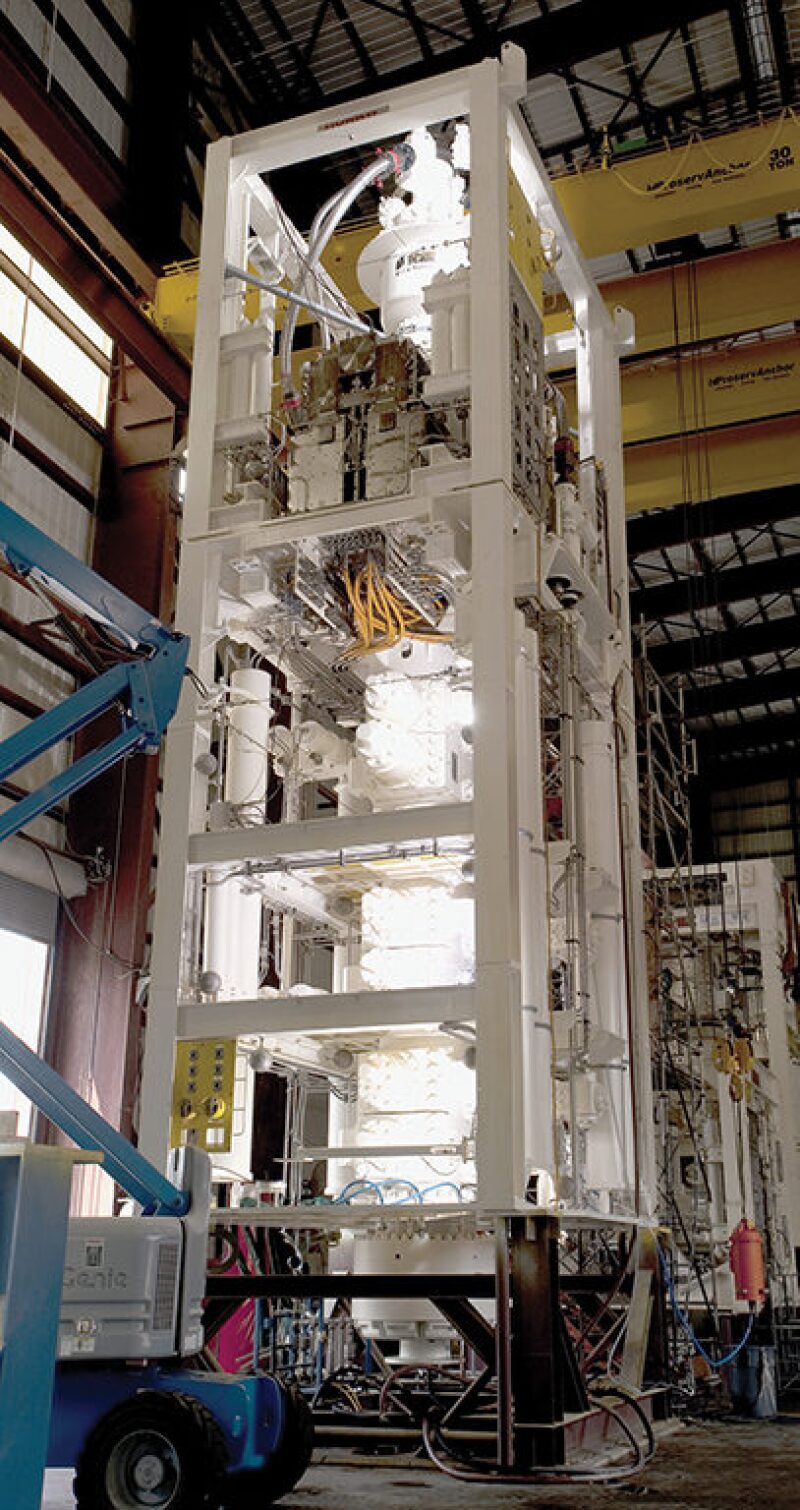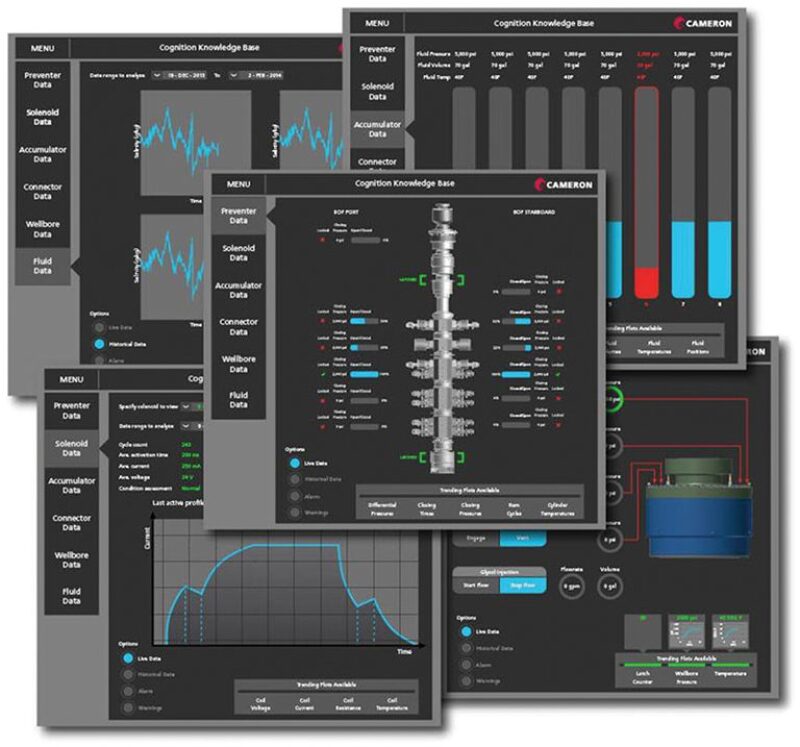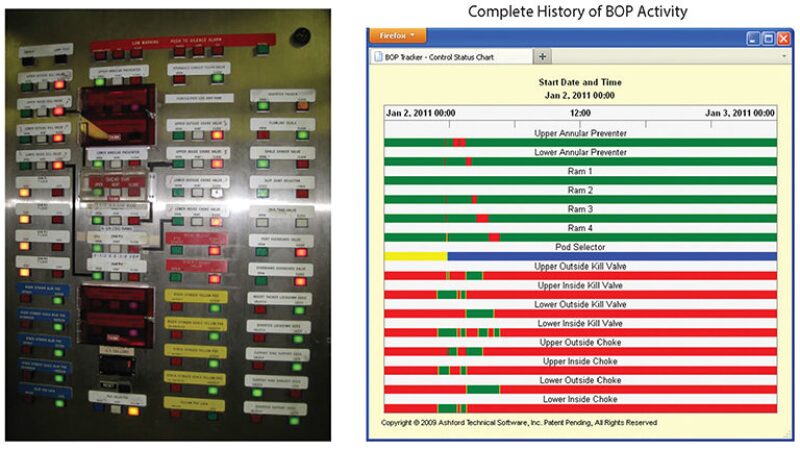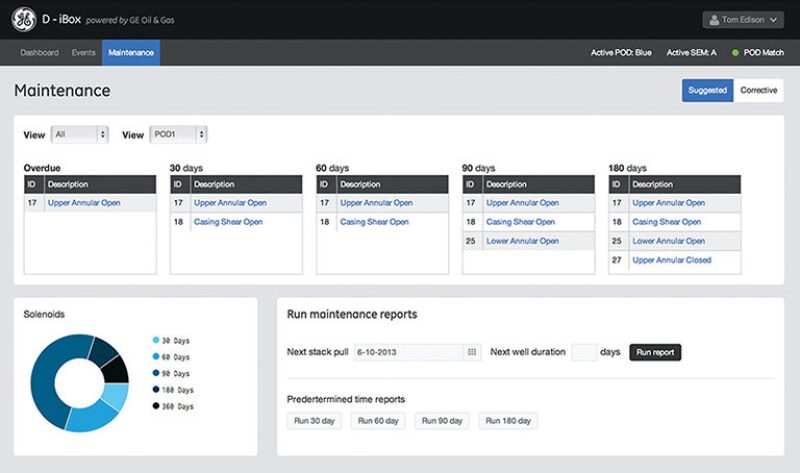A growing trend of heavy industries in the 21st century has been to marry computers and software with large machines to track their performance, and all the hiccups along the way. Known as condition-based monitoring, the process is used to enhance the reliability and performance of railroads, wind turbines, nuclear reactors, and jet engines, but not subsea blowout preventers (BOPs). However, that is slowly starting to change.
All three major BOP makers, as well as some other companies, have introduced BOP monitoring systems that seek to provide new insight into how these massive subsea machines work—and perhaps more important, why they sometimes do not. By improving system reliability, the offshore drilling industry stands to recoup millions of dollars it writes down each year because of BOP downtime.
Today, offshore drillers have little knowledge about the fatigue life of the more than 100 hydroelectric valves and regulators inside a BOP. Makers of BOPs acknowledge that this uncertainty forces companies to replace as much as 25% of the BOP stack each time it undergoes scheduled maintenance to mitigate breakdowns. The practice of arbitrarily replacing parts is only a stopgap measure as drilling contractors report that 50% of downtime on their drilling rigs are caused by problems with BOPs. While they have their differences, the BOP monitoring systems available today seek to completely change this status quo. “The holy grail is to detect a failure early and focus your maintenance efforts on that part, and not just a random part,” said Clayton Simmons, product line manager of BOP monitoring systems at National Oilwell Varco (NOV).
These monitoring systems take readings from the BOP stack and route it to a computer server where software is used to determine how critical components are functioning. The thinking is that if a drilling contractor can predict a problem, or how far along a part is in its service life, then the BOP can stay on the bottom longer without coming up to the rig for repairs. “Compared to where the industry is now, this is a crystal ball,” said David McWhorter, vice president and general manager of drilling systems at Cameron.
Because this technology is relatively new and is being used only on a handful of offshore rigs, it will take time to collect enough information to change how the industry addresses maintenance issues. A future step for many of the technology developers will be to use sensors on and inside the BOP to gather more information for the analytic software programmed to serve as automated maintenance advisers to offshore drilling contractors.
Increasing Demand
NOV installed its BOP monitoring system on its first rig over 3 years ago; now the system is being tested on three rigs and the company expects that number to grow to 10 this year. In its second phase of development, the company’s monitoring system is facing increased competition. GE Oil and Gas and Cameron unveiled new BOP monitoring systems at the Offshore Technology Conference in Houston in May. Cameron is upgrading its first BOP with its monitoring system and two companies, US-based Atwood Oceanics and Brazilian-based Queiroz Galvão Óleo e Gás, have ordered monitoring systems from GE.

Ashford Technical Services was the first to introduce a BOP monitoring system in 2009 on a Diamond Offshore drilling rig in the US Gulf of Mexico. Since then, the company has installed monitoring systems on three rigs operating in Asia Pacific and Australia, and on a rig that is heading to the North Sea. The company said it is expecting to add the system to another rig in the coming months. Most of the installations are for medium-depth and deepwater rigs.

Despite the growing number of rigs using BOP monitoring systems, the technology is still on the low side of the uptake curve. One potential factor that could increase adoption remains in doubt. Some in the offshore industry thought that subsea BOP monitoring would become a requirement for drilling in US waters after the Deepwater Horizon blowout in 2010 that killed 11 crewmen, but “right now, there is no industry regulatory driver for this,” said McWhorter. “This is simply good business.”
Unknown Life Cycles
Overhauling the offshore drilling industry’s maintenance practices will begin with knowing the life cycle of an individual component. A 2013 report made public by the Bureau of Safety and Environmental Enforcement (BSEE), the primary offshore regulatory body in the United States, highlighted the need for monitoring systems by citing an example of a BOP test gone wrong. The report recounted an undated event involving a deepwater rig that was unable to complete a subsea test of the BOP’s shear ram when a control valve malfunctioned.

The BOP had to be pulled up to the rig and fixed before being sent back down to the well. The 2-week process cost the drilling contractor more than USD 10 million in lost revenue. The BSEE report concluded that had the drilling contractor known how many cycles the valve had been through, the component could have been replaced before it failed.
Without knowing the durability of each part, most drilling contractors have adopted a time-based maintenance program that calls for the replacement of up to a quarter of a BOP’s moving parts once a year—whether they need to be or not. “What is the expected lifetime of that valve in terms of number of cycles? If you ask the manufacturer, you do not get a very good answer,” said Frank Chapman, president of Ashford.

His company has been collecting data from its monitoring system, RigWatcher, for nearly 6 years and is ready to start mining the data to determine the life cycles of BOP parts. Chapman envisions that this could one day help BOP makers design longer-lasting valves and other components. Detailed usage and fatigue information has to be collected from each valve and then compared with the stated life expectancy of the component. “Given that, then you can start to improve the manufacturing process or the design so that you can increase that life cycle,” Chapman said. “But without any data to start with, you are shooting into the dark.”
Using Dark Data
Monitoring systems available today rely upon the raw data generated when commands are sent from the rig to the BOP control pod to turn a valve or close a ram. The monitoring systems obtain the data and transmit it without interfering with the control system. This eliminates the risk of unintentionally causing a problem within the BOP control system. Although a BOP is a hydraulically controlled system, each action that it performs produces a unique electrical signature in the control pod that is recorded. Using a monitoring system’s algorithms, the signatures are interpreted to determine the health of an individual moving part.
Because these electrical signatures have traditionally taken a lot of time and effort to properly interpret, some call it “dark data.” This raw data is now the crux of most monitoring systems, including GE’s SeaLytics, and will be used to begin establishing performance trends and creating new maintenance guidelines, said Bob Judge, director of product management for drilling systems at GE. “We had this nice set of data that we didn’t do anything with,” he said. “Nobody was shining a light on it, and saying, ‘What can I learn from this?’”
Transocean Going its Own WayAbsent from the list of drilling contractors using commercially available blowout preventer (BOP) monitoring systems is the world’s largest: Transocean. That is because the company is taking its own approach. Last year, Transocean announced that it is working on a 3-year project with Shell to develop fault-resistant and fault-tolerant control systems that could be used to retrofit BOPs currently in use. A control system acts as the nerve center of a BOP and when it goes down, so goes the entire stack. Unfortunately for Transocean and many other drilling contractors, breakdowns happen frequently as control system failures are attributed to roughly half of the downtime incurred by BOPs. When it comes to the BOP monitoring systems offered by other companies, Transocean’s director of technology and innovation, Jose Gutierrez, said what his company is looking for is yet to be developed, and made the case that simpler is better. “We do not need to do deep analytics,” he said. “If you want to know when something is going to fail, just count how many times you have used it—count the cycles.” Gutierrez said he and his subsea engineers are concerned about relying on sensors to monitor a BOP. They point to the risk of the sensors themselves failing, which could cause a driller to unnecessarily pull a BOP stack off the well. Others point to the risks created by inserting sensors and cables inside pressurized areas of the BOP. “We should have more BOP data but we do not have the sensors to get it,” he said. However, he points out, “If we put sensors in, then there is another challenge since it would be another point of failure.” Nonetheless, Gutierrez added that drilling contractors have been able to cope with the problems that sensors introduce, and successfully reduce repair times and increase the time that it takes to reach a failure by using the proper sensors. “It is a complex problem, but it is a solvable problem,” he noted. |
Each company has designed its own user interface to present the processed monitoring data in a way that highlights the most important information to a driller. The displays mix real-time data with historical information and performance projections to aid in predictive maintenance. On an offshore rig without a monitoring system, how does a tool pusher or rig superintendent know the BOP’s valves actually turned, or the rams actually closed? In short, they do not. Workers on the rig must instead use indirect information, such as flow and pressure, to determine if the BOP carried out the function as instructed. BOP monitoring systems will dig a little deeper by taking the flow and pressure information, along with the hydraulic and electronic signature produced by the valve, to determine if it is working normal or not. The anomalies are then automatically entered into a maintenance report and the component in question is singled out for inspection.

For instance, if the BOP is equipped with the proper sensor, a monitoring system will record how long the shear rams took to close and if they are slowing down over time, the software will try to predict when they may wear out. Judge noted that it takes some time for the software to sort out the signals and what they indicate. “With all these programs that rely on data,” he said, “you have to start somewhere; once you start collecting the data, then you can analyze it.”

NOV is beginning to sort out the meaning of the signals. The company is entering the second phase of its 2-year-long pilot program to assess its monitoring system, eHawk, which is installed on two Ensco-owned rigs and one Noble rig. NOV is storing BOP data at its own onshore facility where it is aggregated and made available to the drilling contractor through a user interface. By next year, it hopes to use this information to establish baselines of normal performance signatures from those associated with the wearing down of a part. Simmons said that by separating the good hydraulic signatures from the bad ones, “we can help them focus on a specific valve that may be showing an odd signature, that may be passing a pressure or function test, but could possibly fail the next time it is deployed.”
Subsea Sensors
One major consideration concerning BOP monitoring is the use of sensors. A popular school of thought says adding sensors means adding more components that can break down and lead to the BOP being pulled. This is part of the reason that of today’s monitoring systems, none are inherently reliant on aftermarket sensors to collect data but the developers expect sensors to take on a greater role as monitoring technology matures. “We have a really good data set without a lot of additional instrumentation,” said Judge who noted that adding a system, such as SeaLytics, to a BOP is easier than adding a new sensor to it. However, “if there are missing links in the data, that too will be revealed through the software and then a sensor can be designed to be installed to gather the data,” he said.
Cameron’s engineers see the potential for up to 80 kinds of sensors to be placed on a BOP to gather condition data—customers will ultimately decide how many they want to install. These sensors could track temperature and pressure changes and the condition of the accumulator bottles. One of the sensor systems that Cameron is working on is an ultrasonic device that can tell within a fraction of an inch the location of each piston inside the BOP. The sensor was originally designed to measure gas flow. “It is a key part of the technology and we envision that it will be one of the primary sensor types that will be employed in this system,” McWhorter said.
GE upgraded its BOP ram position indicators, a technology based on Deepwater Horizon learnings, that indicates the degree to which the rams are open or closed by using a pressure transducer that records the amount of pressure it took to complete the action. “As the pressure fluctuates over time,” Judge said, “that is telling you something about the health of what is inside those things.”
Enabling Onshore Experience
As far as communication goes, today’s BOPs are simple creatures. Basic, yet critical, operational data is sent from the BOP back up to the rig floor where temperature and pressure readings are displayed. And it stops there. If a project manager working onshore needs to know the status of the BOP, for instance, as a means to determine well pressure, then he or she would either have to wait for a daily email update or phone the rig and request the information. The monitoring systems allow the drilling contractor to link the information coming off the rig to anywhere in the world via satellite uplinks and the Internet.
With remote monitoring, a team of onshore specialists can troubleshoot problems on not only one rig, but also multiple rigs. “You can bring the experts you need around the table pretty quickly without having to put them on a plane and a helicopter to get them to the rig,” said Judge. Instead, “they just pull it up on their laptop and see what is happening,” he said.
Monitoring systems can also help the industry in coping with the “great crew change.” The industry is losing many of its most experienced personnel to retirement and filling the ranks will be talented, but less experienced workers. With a BOP monitoring system that is integrated with an onshore operations center, “one senior subsea technician, for example, can assist many junior technicians that are on the rig,” said Simmons of NOV. “He is looking at the same diagnostic screen as on the rig, but he has more experience and can help make better decisions.”
Bigger Data Ahead
For GE, one of the next steps in the evolution of its monitoring system will be to combine the performance and condition data from different drilling contractors, and store this information in a secure database in which the aggregate data could be used to provide fleetwide performance learnings. Collecting operational data from machinery for pattern analysis is a common practice in the transportation and energy generation industries; however, it is not happening in the offshore industry. While some of GE’s other business units have persuaded customers from the transportation, aviation, and energy generation industries to share performance information, “I do not think it happened overnight,” Judge said, noting that it is a long-term goal.
Moving forward with the development of its monitoring system, Cameron plans to work closely with its customers to come up with additional algorithms that will best suit their needs. Its customers can use the analytic systems that Cameron designed, third-party protocols, or extract the data and apply their own analytics. NOV purchased artificial intelligence software to validate its results and refine its approach. The company also has plans to release analytic programing later this year to its drilling contractor customers to allow them to analyze the data themselves.
BOP Black BoxesMost companies using blowout preventer (BOP) monitoring systems have developed so-called black box technology that stores vital forensic data to assist in emergency responses and investigations of well control incidents or a sinking rig. The genesis of Cameron’s newly unveiled BOP monitoring system was born from the development of a BOP black box. The company’s hardened system records and stores 3 weeks’ worth of data that can be retrieved using a remotely operated vehicle (ROV). One of NOV’s black box systems is located on board the rig and in a catastrophe in which the rig is lost, the black box is jettisoned into the water. Equipped with a homing beacon, an ROV can recover the black box from the bottom of the sea and retrieve the data. GE Oil and Gas has also introduced a black box modeled after the technology that its aviation business provides to commercial airliners. Trendsetter Engineering, a company specializing in well control equipment, will be introducing its black box technology next year. In addition to BOPs, the black box can be installed on subsea production systems and trees. “It is the same idea as a black box for an airplane,” said Mauricio Madrid, director of projects at Trendsetter. “It is independently powered and information is independently retrieved.” The company’s black box works by continuously monitoring, gathering, and storing all the critical information being produced by electronic sensors on a BOP. In addition to operational data, Trendsetter has designed its black box system to store the final engineering drawings used to build the BOP, well plans, schematics, part numbers, and historical data, such as each time the device was tested and certified. The data inside the black box can be transmitted to a ROV using an acoustic data system, so a wet-mate connection is not required. In a single pass, the ROV can download the information from the black box and transmit it in real time to the surface by means of the ROV’s umbilical. The value is that all the information about the BOP, the well, and even the rig is centralized and easily accessible to incident responders to aid in their decision making, and later for an investigation. “This black box concept is just another step change in getting people to understand that we cannot continue to do things the way we were doing them before,” said Madrid. “We have to think outside the box and mitigate unforeseen issues.” |
Future Sensor Development
Cameron’s monitoring system is also designed to determine the condition of the rubber packers inside the BOP. Like all rubber components, the material degrades over time and the system is used to identify how far along they are in their fatigue life. “That is something that is very, very difficult to do when you are on a well subsea,” McWhorter said. “We know that there is a virtual one-to-one correlation with the position of the piston and how much rubber volume is left,” he said. “So if you know the position of the piston, if you know the pressure that may be on that packer, you can tell how much rubber is used up.”
McWhorter noted that this feature could be even more valued when evaluating the condition of a BOP’s annular packers. “Unlike ram packers, which just open and close on static pipe for most of their life, annular packers are subject to having pipe stripped through them, tool joints pulled through them, pipe rotated, and all kinds of events that can accelerate the wear of that annular packer,” he said.
Cameron is developing a sensor that will be placed inside the borehole of the BOP to analyze the fluid makeup as it flows up to the rig to see if bits of metal or pieces of rubber from a seal are present. It said these problems are known to have a direct effect on the condition of the pistons and valves inside a BOP stack. McWhorter said, “If we perfect that sensor and we can perfect the algorithm that goes along with it that has the ability to give an operator or drilling contractor the confidence that the condition of their fluid is good.”
NOV is looking for a way to detect the contamination level of the BOP’s hydraulic fluids. A BOP’s hydraulic fluid is 97% water and 3% glycol. As with any standing body of water, bacteria and algae begin to form colonies, which can cause serious damage to a machine such as a BOP. Currently, routine samples are taken from BOPs while on the rig and mailed off to be analyzed. “By the time those results come back in,” Simmons said, “the (BOP) likely has already been flushed and you have a whole new set of fluids in there, so it is very tough to determine what is actually happening to your system with regard to contaminant level in the fluid.” Working with its customers, NOV thinks it can use a sensor to monitor the buildup of bacteria and algae in real time so the crews on the rig can change the hydraulic fluids out sooner or change filters to prevent contamination.


